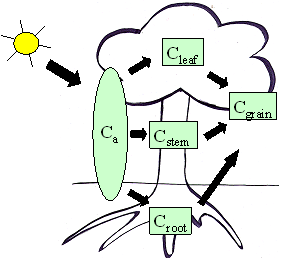Allocation to different parts of the plant
The plant biomass is divided into five compartments of carbon and nitrogen for grain crops (CLeaf, CStem, CRoot, CGrain, CMobile, NLeaf, NStem, NRoot, NGrain and NMobile) (see Figure 5.1). The mobile pools are a kind of luxury storage pools that contain nitrogen and carbon that can be used at special occasions for example at leafing. Three additional compartments exist for perennial plants (COldLeaf, COldStem, COldRoot, NOldLeaf, NOldStem, NOldRoot) for carbon and nitrogen respectively. The “old” compartments for perennial plants consist of biomass assimilated in previous years. Consequently at some time the carbon and nitrogen in the new biomass pools have to be considered as old and therefore have to be allocated from the new to the old pools. This allocation process takes place at the beginning of each year, when all the accumulated carbon and nitrogen in the plant from the previous year is allocated to the “old” biomass pools, unless the plant is less than 180 days old. Consequently the “new” biomass pools are always empty in the beginning of each year in perennial plants (with the exception of very young plants).
Figure 5.1. Carbon pools in a tree. The grain pool represents all kinds of reproductive organs e.g. fruit, seeds, cones etc. There is also a mobile pool that perennial plants can use at leafing.
The initial amounts of nitrogen in each compartment at the start of the simulation can be specified in the parameter table Initial Conditions of plants. Based on these figures initial amounts of carbon are calculated from the CN-ratios specified in the parameter table Initial CN ratios of plants. In Initial Conditions of plants the plant age must also be specified. If the plant is not yet sown the initial age should be put to zero.
There are no principal differences between annual and perennial plants in the functioning of photosynthesis and many other processes in the model. Instead the main differences in growth rates and structure are caused by differences in allocation patterns, which have to be specified separately for each plant as described in the section Allocation of Carbon.
Allocation to the different compartments is governed by the plant development stage and different environmental responses. The allocation pattern is similar for carbon and nitrogen but some important differences are found.
In the sections below we first describe the different stages of plant development and how they are calculated in the model. Next the allocation flow for carbon and nitrogen to the different compartments will be described.

 Plant lifecycle
Plant lifecycle